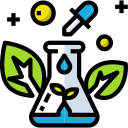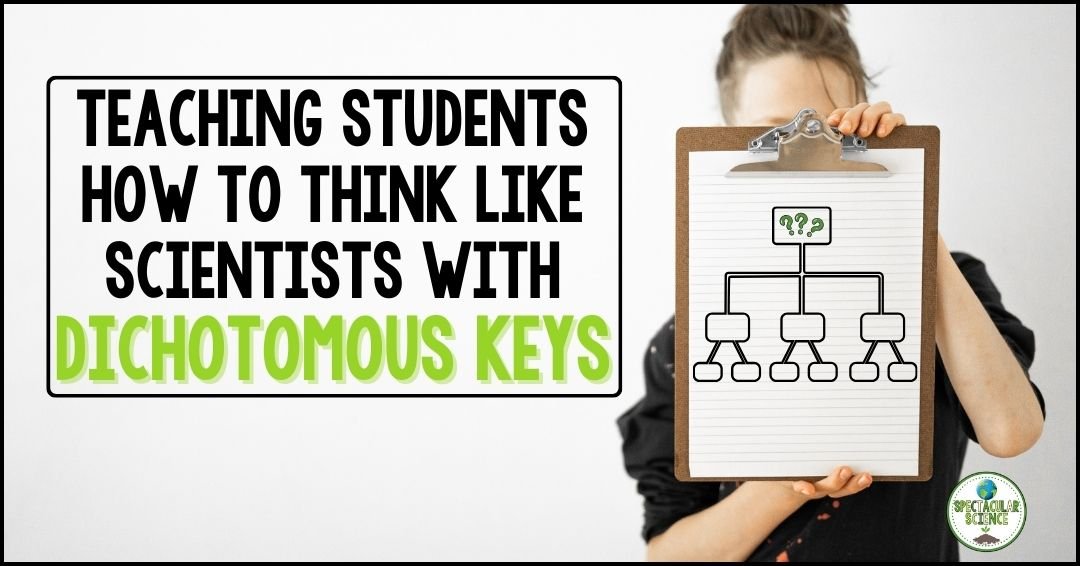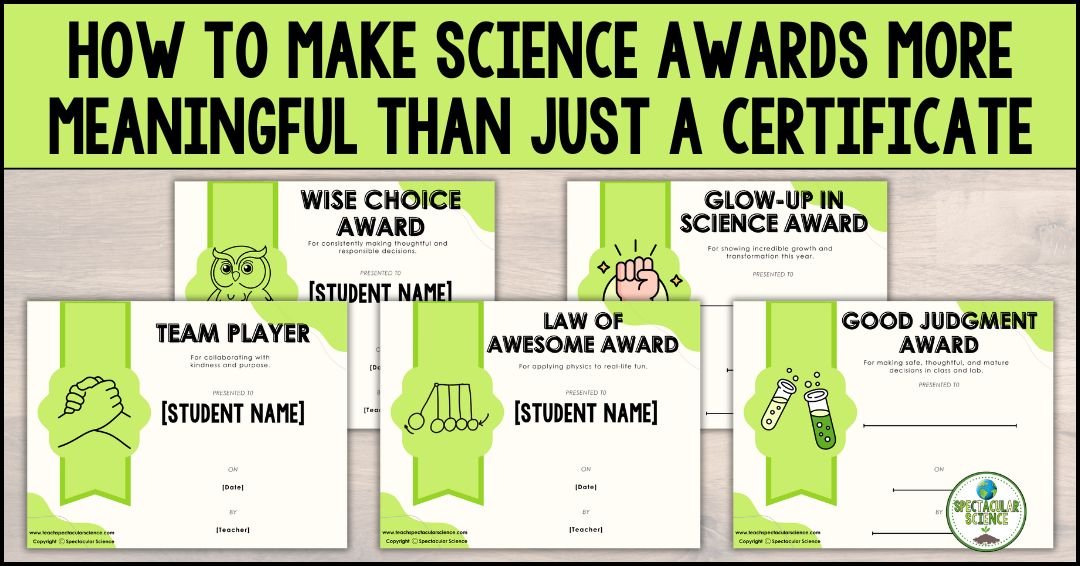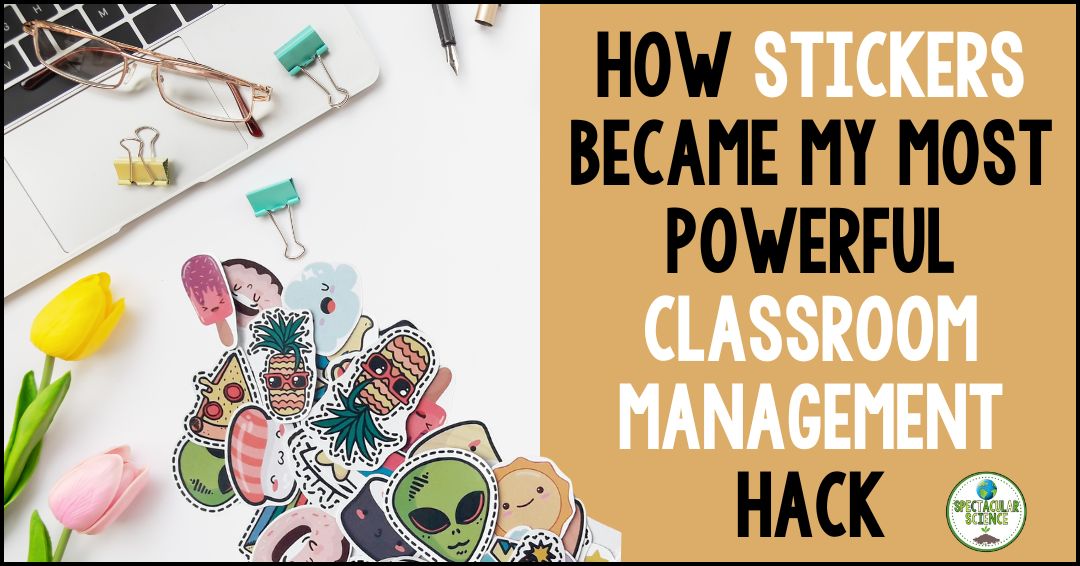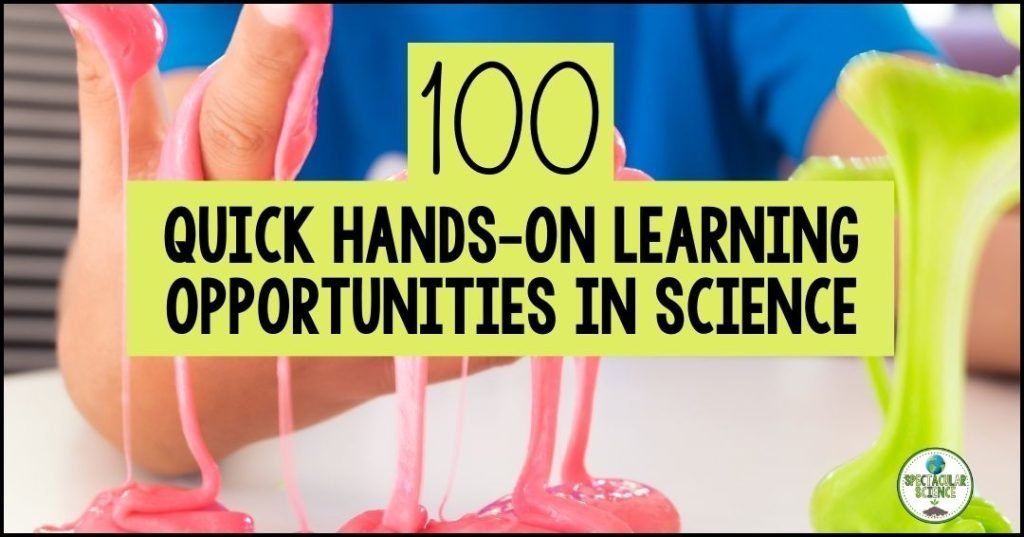
Let’s remember that the best learning experiences are often the most memorable. They transcend the boundaries of textbooks, allowing students to explore, question, and discover for themselves. These activities aren’t just about imparting knowledge; they’re about cultivating a spirit of inquiry that will last a lifetime.
As educators, we understand that time is often of the essence, and finding quick yet impactful activities is key to keeping students engaged. Whether you’re delving into Earth Science, Environmental Science, or other scientific realms, here are 100 bite-sized hands-on learning opportunities to infuse excitement into your classroom.
25 hands-on learning opportunities in earth Science
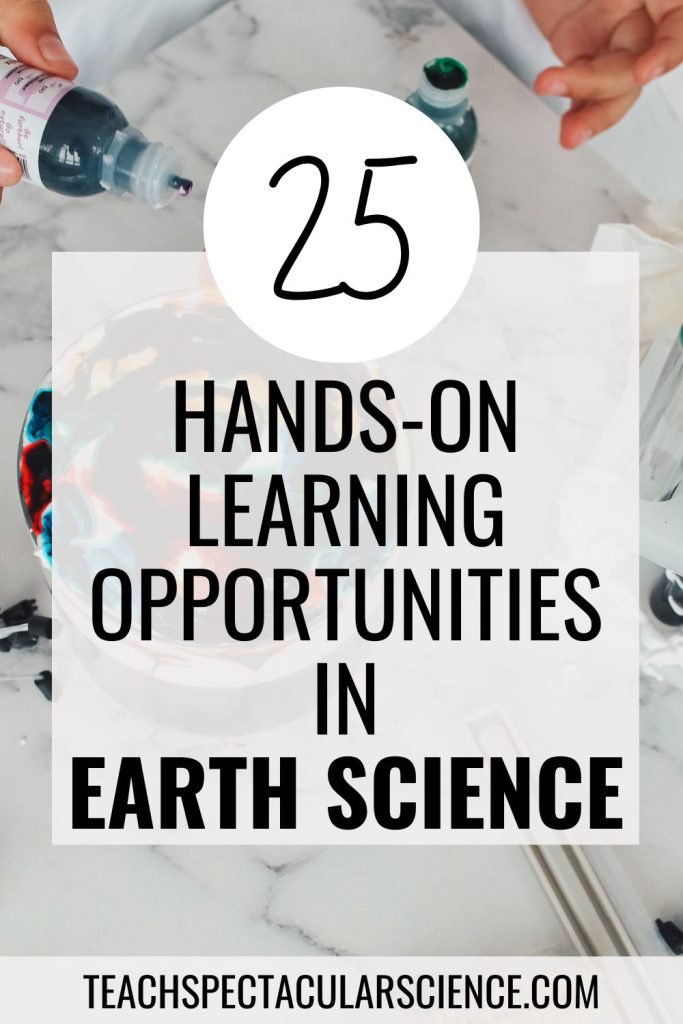
Explore the wonders of Earth science with these 25 engaging hands-on learning opportunities! From rock formations to weather patterns, these activities make learning about our planet exciting for students of all ages.
1. Simulating Plate Tectonics with Graham Crackers:
Breaking, shifting, and colliding graham cracker pieces provides a tactile experience that vividly demonstrates the dynamic forces responsible for shaping Earth’s crust. As the crackers move against each other, students can observe firsthand how tectonic plates interact, leading to the formation of mountains, earthquakes, and other geological features. Grab a done-for-you Snack Tectonics Lab here.
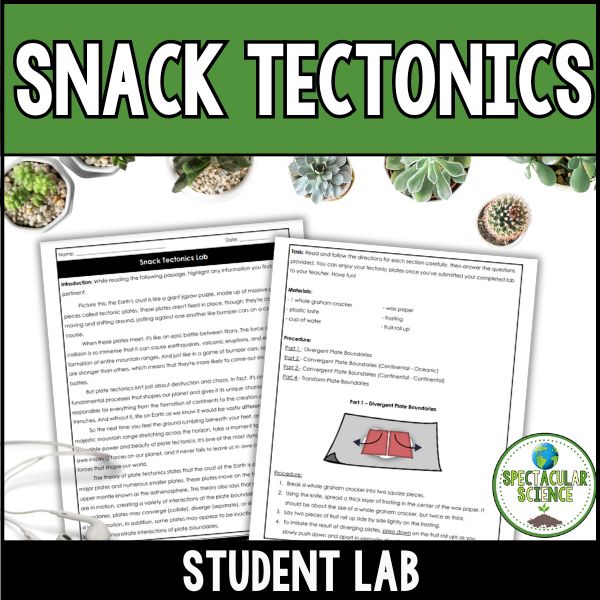
2. Creating Sedimentary Rock Layers with Sand Art:
Layering colored sand in an art project mirrors the geological processes of sedimentation and rock formation. By understanding how different sediment layers accumulate over time, students gain insights into the origins of sedimentary rocks and the environmental conditions that influence their composition.
3. Modeling the Water Cycle with Ziplock Bags:
Sealed Ziplock bags serve as miniature environments where students can witness the water cycle in action. Condensation forms on the bag’s surface, simulating clouds, which then lead to precipitation and eventual evaporation. This hands-on activity offers a visual and interactive way to comprehend the continuous natural process of water circulation.
4. Investigating Soil Composition with DIY Soil Jars:
Creating mini-soil profiles in jars enables students to explore soil layers and understand the components that support plant life. By observing the distinct layers, such as topsoil, subsoil, and bedrock, students gain a practical understanding of soil composition and its significance in fostering plant growth.
5. Unearthing Fossil Impressions in Plaster:
Excavating “fossils” from plaster molds provides a tangible experience in the field of paleontology. Students can explore the concept of fossilization, uncovering imprints of ancient organisms and understanding how geological processes preserve remnants of prehistoric life over time.
6. Exploring Mineral Properties with a Scratch Test:
Testing the hardness of minerals through a scratch test with common objects offers a hands-on approach to understanding mineral properties. By discovering the correlation between scratch resistance and mineral hardness, students gain valuable insights into mineral identification and classification. This Mineral Identification Lab will set you (and your students) up for success.
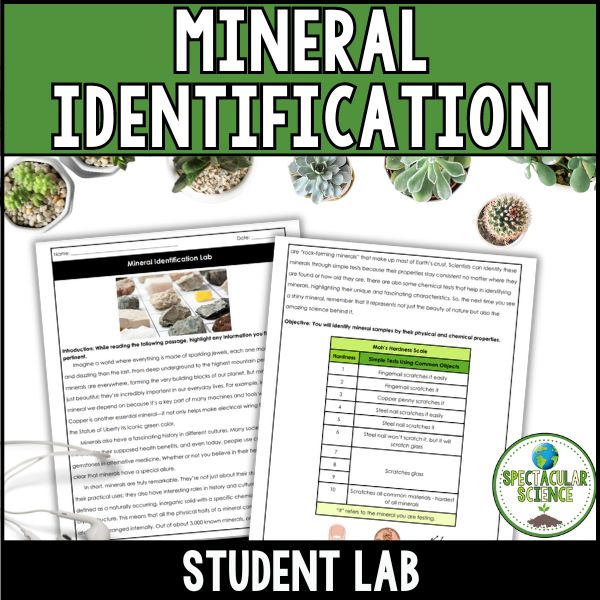
7. Designing and Testing Paper Airplane Weather Models:
Constructing paper airplanes to explore the impact of weather conditions on flight patterns engages students in meteorology. By observing how different weather factors affect the flight of their models, students develop a practical understanding of the atmospheric forces influencing aviation.
8. Constructing Volcanoes with Baking Soda and Vinegar:
Triggering miniature eruptions with baking soda and vinegar allows students to witness and comprehend the basics of volcanic activity. This explosive experiment illustrates the release of gases and magma, emphasizing the dynamic nature of Earth’s geology.
9. Mapping Topography with Contour Lines:
Molding Play-Doh to represent different elevations and creating a tactile map with contour lines helps students grasp the concept of topography. This hands-on activity enables students to visualize landscapes and understand how contour lines convey elevation changes on maps.
Designed for middle school and high school students, this interactive lab takes geography and earth science to new heights, allowing learners to delve into the art of interpreting topographic maps with ease. From understanding contour lines to unraveling elevation changes, this lab transforms complex concepts into captivating adventures.

10. Observing Cloud Types and Predicting Weather:
Identifying cloud formations using cotton balls and linking them to upcoming weather predictions engages students in atmospheric science. By creating cloud models and understanding their implications on weather patterns, students develop observational skills crucial for forecasting.
11. Analyzing Stream Erosion with Stream Tables:
Manipulating miniature landscapes to observe the impact of flowing water on erosion provides a visual representation of geological processes. Students can experiment with variables such as slope and sediment type to understand how stream erosion shapes landscapes over time.
12. Measuring Solar Altitude with Shadows and Angles:
Tracking the sun’s movement by measuring shadows at different times of the day deepens students’ understanding of solar altitude. This activity allows students to appreciate the Earth’s axial tilt and its role in influencing the length and direction of shadows throughout the day.
Want more? This no-prep unit encourages students to investigate how the daily apparent path of the sun changes with each season. Students are introduced to the following concepts and terms: zenith, celestial sphere, solar noon, Tropic of Cancer, Tropic of Capricorn, solstices, equinoxes, shadows, etc.
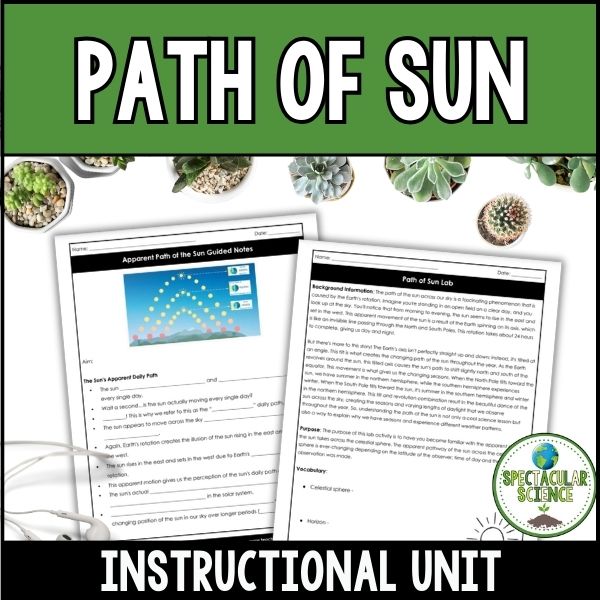
13. Investigating Earthquake Waves with Jell-O:
Shaking up Jell-O to understand the principles of seismic waves and earthquake behavior offers a fun and interactive way to explore seismology. Students can observe how different types of waves travel through the gelatin, simulating the dynamics of earthquake propagation.
14. Calculating the Circumference of the Earth with Eratosthenes’ Experiment:
Following in the footsteps of Eratosthenes by measuring shadows to estimate Earth’s circumference provides a historical perspective on scientific inquiry. Students can grasp the concept of triangulation and appreciate the ancient methodology used to approximate the Earth’s size.
15. Exploring the Coriolis Effect with Spinning Tops:
Spinning tops on a rotating surface allows students to witness the Coriolis effect in action. This hands-on demonstration helps students understand how the rotation of the Earth influences the trajectory of moving objects, emphasizing the impact of Earth’s rotation on global phenomena.
16. Constructing Sun Dials for Solar Time Measurement:
Building sundials provides a practical experience in measuring time based on the sun’s position. Students can observe how the sun’s shadow changes throughout the day, gaining insights into the Earth’s rotation and the concept of solar time.
17. Identifying Rocks and Minerals with a Rock Hunt:
Organizing a rock hunt encourages students to apply their knowledge of rock and mineral identification in a real-world setting. By collecting and classifying specimens, students reinforce their understanding of geological diversity and learn to recognize different rock types.
Here are more structured hands-on learning activities when teaching rock identification and mineral identification.

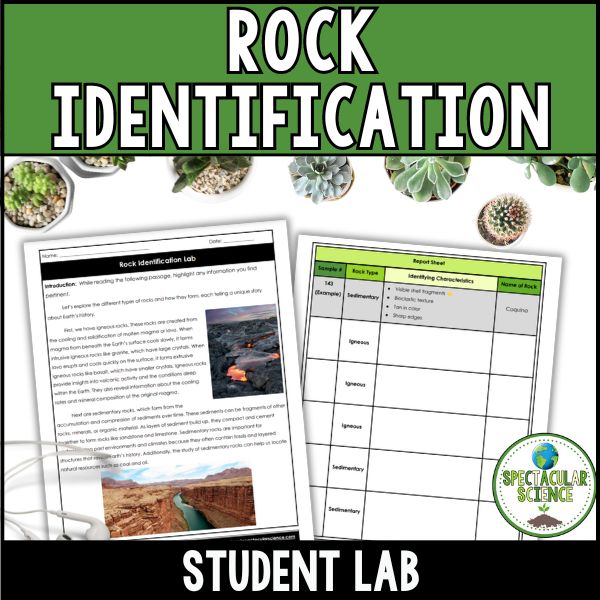

18. Modeling the Phases of the Moon with Oreos:
Turning Oreos into a delicious representation of the moon’s phases makes astronomy both engaging and tasty. Students can visually connect the changing shapes of the cookie to the moon’s lunar phases, providing a memorable and palatable introduction to celestial observations.
19. Simulating Glacier Movement with Clay:
Molding clay to observe the flow and deformation characteristics of glaciers offers a hands-on approach to glaciology. Students can model the movement of glaciers and understand how ice dynamics shape landscapes over extended periods.
20. Exploring Magnetism with Iron Filings:
Sprinkling iron filings to visualize magnetic field lines around various magnets provides a tangible illustration of magnetism. This activity allows students to observe and understand the invisible forces at play in magnetic fields, fostering a deeper comprehension of magnetic properties.
21. Investigating the Properties of Convection Currents:
Observing convection currents by adding food coloring to hot and cold water engages students in fluid dynamics. This hands-on experiment helps students comprehend the movement of fluids due to temperature differences, illustrating the concept of convection.
22. Measuring Wind Speed with Homemade Anemometers:
Constructing anemometers with cups and straws offers a fun and interactive way to measure wind speed. By testing their homemade devices in different wind conditions, students gain practical insights into the factors influencing wind speed and direction.
23. Demonstrating the Greenhouse Effect with Jars and Heat Lamps:
Using jars and heat lamps to illustrate the greenhouse effect provides a visual representation of Earth’s climate dynamics. This hands-on experiment allows students to witness how certain gases trap heat in the atmosphere, fostering a deeper understanding of climate science.
24. Studying Weathering and Erosion with Sugar Cubes:
Simulating weathering and erosion by exposing sugar cubes to different environmental conditions offers a tangible demonstration of geological processes. Students can observe how external factors impact the integrity of the sugar cubes, drawing parallels to natural weathering and erosion.
The Sugar Cube Weathering Lab involves observing the gradual erosion and weathering of sugar cubes as they simulate geological processes, providing a hands-on experience to understand the effects of natural forces on Earth’s surface.

25. Analyzing Ice Cores for Climate Change Insights:
Exploring the concept of ice core sampling and its role in understanding past climates allows students to delve into paleoclimatology. By analyzing ice cores, students can uncover historical climate data, gaining valuable insights into Earth’s climatic variations over time.
25 hands-on learning opportunities in environmental science
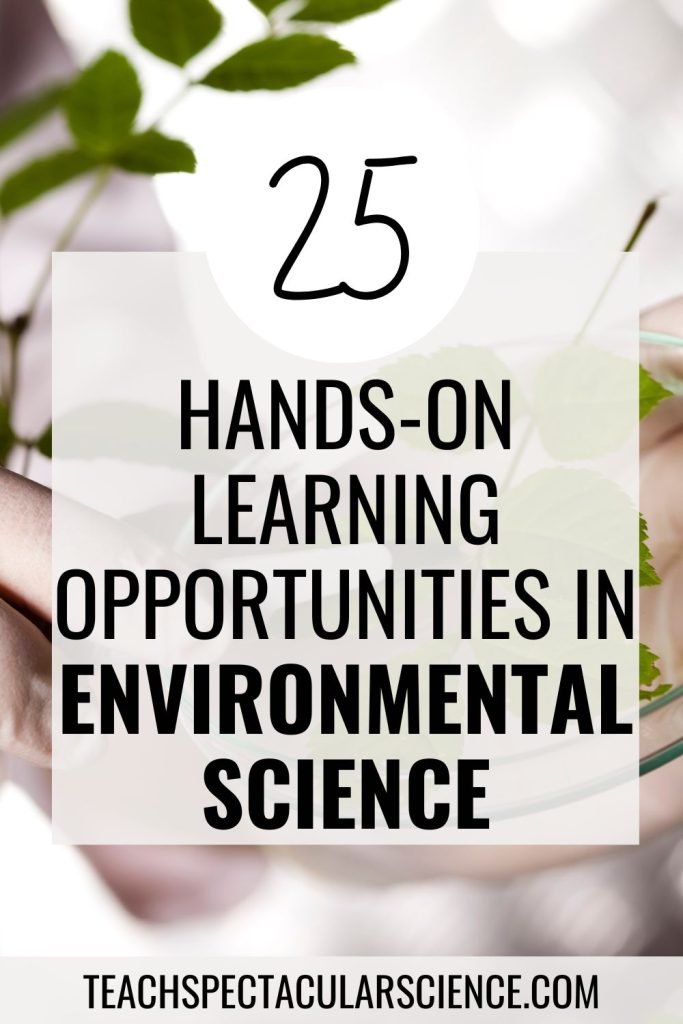
Dive into the world of environmental science with 25 captivating hands-on learning opportunities. Educate and inspire students about ecosystems, conservation, and sustainability. From wildlife observation to recycling projects, these activities foster a deep connection to the environment.
1. Constructing Miniature Eco-Friendly Homes:
Engage students in sustainable architecture by having them design and construct miniature eco-friendly homes using recycled materials. This hands-on activity allows them to explore the principles of energy efficiency, resource conservation, and eco-friendly design while fostering creativity.
2. Investigating Water Pollution with DIY Water Filters:
Through the creation of do-it-yourself water filters, students can actively explore the impact of water pollution on aquatic ecosystems. This hands-on experiment provides insight into filtration methods and the importance of clean water, fostering an understanding of environmental challenges and potential solutions.
On this topic, check out this Clean Water lab, which is intended to take between 40 – 60 minutes and requires students to complete tasks both inside and outside of the classroom. They are also tasked with creating a poster to spread the word about water pollution.
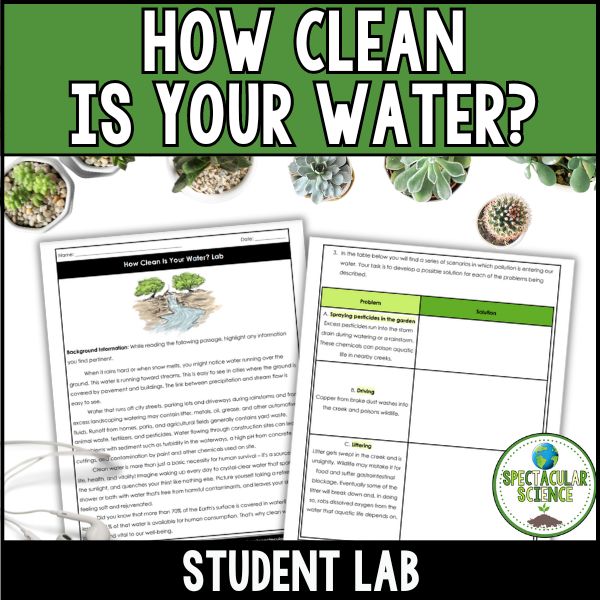
3. Building Model Landfills to Understand Waste Management:
Constructing model landfills offers a practical approach to teaching waste management concepts. Students can explore the challenges of landfill design, waste decomposition, and the importance of reducing, reusing, and recycling materials to minimize environmental impact.
4. Testing Soil pH with Red Cabbage Indicator:
Utilizing a natural indicator like red cabbage, students can measure soil pH in a visually engaging experiment. This hands-on activity not only introduces fundamental concepts of soil science but also highlights the importance of maintaining proper pH levels for plant growth and ecosystem health.
5. Simulating Acid Rain Effects on Plant Life:
Create a simulated acid rain environment using vinegar or other acidic substances to demonstrate the detrimental effects on plant life. This experiment allows students to understand the real-world consequences of acid rain and promotes discussions on environmental policies and practices to mitigate its impact.
6. Identifying Biodiversity through Leaf Litter Exploration:
Encourage students to explore biodiversity by examining leaf litter from different environments. This activity provides a tangible way to understand ecosystem diversity, emphasizing the interconnectedness of various species and the importance of preserving habitats.
7. Measuring Air Quality with DIY Air Quality Monitors:
Empower students to monitor air quality by building their own DIY air quality monitors. This hands-on experience not only introduces the concept of air pollution but also encourages students to collect and analyze data, fostering a deeper understanding of the environmental factors influencing air quality.
8. Studying Microorganisms in Pond Water:
Collect pond water samples and study the microorganisms within, allowing students to gain insights into the importance of microbial communities in aquatic ecosystems. This hands-on exploration enhances their understanding of biodiversity and the crucial role microorganisms play in maintaining ecological balance.
9. Creating Terrariums to Explore Ecosystems:
Build terrariums to simulate ecosystems, providing students with a tangible way to observe the interactions between plants, animals, and their environment. This hands-on project enhances understanding of ecological relationships and the delicate balance within ecosystems.
10. Analyzing Carbon Footprints with Household Calculations:
Engage students in a practical exploration of carbon footprints by analyzing their household activities. This activity not only promotes awareness of individual environmental impact but also encourages critical thinking about lifestyle choices and their contributions to climate change.
Throughout this week-long, low-prep unit, students focus on global ecological footprints while studying the following essential question, “How sustainable is your current lifestyle?” Students are introduced to the following terms: sustainability, sustainable society, affluence, hectare, ecological footprint, habitat destruction, etc.
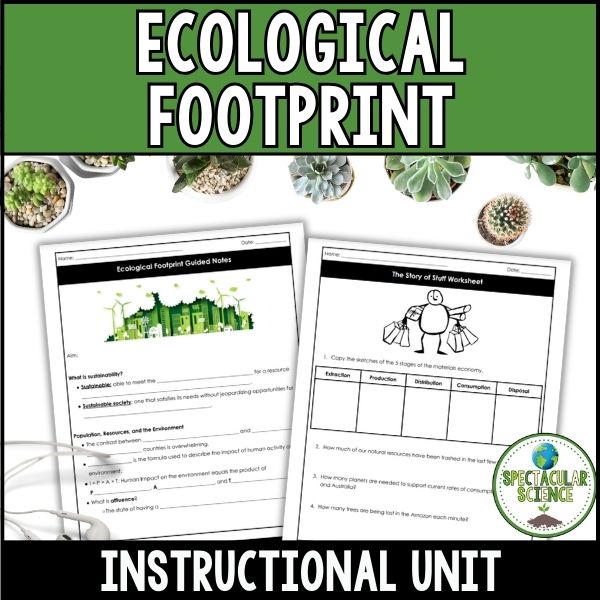
11. Investigating the Impact of Oil Spills on Feathers:
Simulate the effects of oil spills on wildlife by conducting experiments with feathers and various substances. This hands-on activity allows students to observe firsthand the challenges faced by birds and aquatic animals in the aftermath of oil spills, fostering awareness about environmental disasters and the importance of oil spill response strategies.
Love this idea? Here’s a done-for-you Oil Spill Cleanup Simulation Presentation, Lab and Answer Key. Your students will be actively engaged in conducting experiments, evaluating cleanup materials, and developing comprehensive cleanup plans. This lab encourages critical thinking as they weigh the effectiveness of materials against their potential environmental impact.
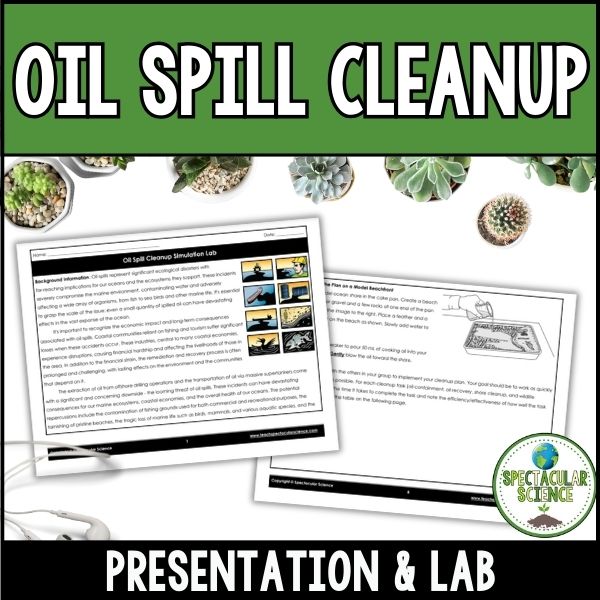
12. Designing and Testing Wind Turbines for Renewable Energy:
Encourage students to explore renewable energy sources by designing and testing their own wind turbines. This hands-on project not only introduces engineering principles but also highlights the potential of wind energy in sustainable power generation, sparking discussions on clean energy alternatives.
13. Mapping Watersheds with Modeling Clay:
Use modeling clay to create a physical representation of watersheds, allowing students to visualize the interconnectedness of water systems. This hands-on mapping activity helps students understand the flow of water, pollution pathways, and the significance of watershed management in preserving water quality.
14. Simulating Population Dynamics with Beans and Cups:
Model population dynamics using beans and cups to illustrate ecological concepts such as carrying capacity, competition, and resource availability. This hands-on experiment fosters an understanding of the factors influencing population growth and provides a tangible way to explore the delicate balance within ecosystems.
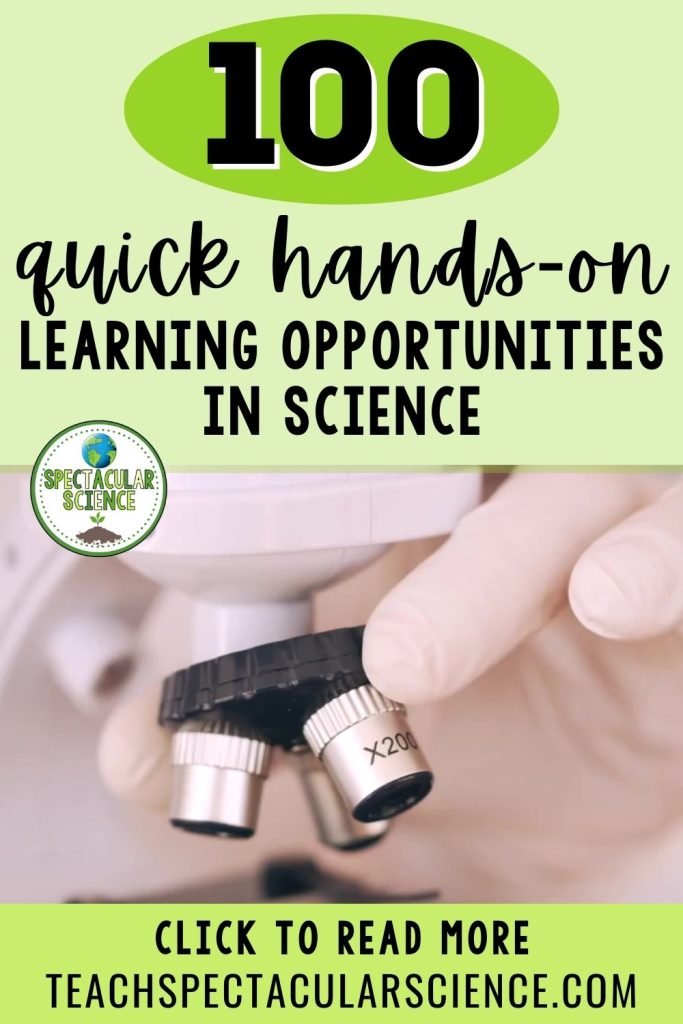
15. Monitoring Butterfly Populations with Transect Walks:
Conduct transect walks to observe and monitor butterfly populations in different environments. This hands-on approach to studying biodiversity allows students to collect data, analyze trends, and draw conclusions about the factors influencing butterfly populations, contributing to a broader understanding of ecosystem health.
16. Exploring Ocean Currents with Bathtub Experiments:
Create simple bathtub experiments to simulate ocean currents and their impact on marine ecosystems. This hands-on activity helps students grasp the dynamics of ocean circulation, influencing climate patterns and marine life distribution, fostering an appreciation for the interconnectedness of Earth’s systems.
17. Modeling Coral Bleaching with Beads and Heat:
Demonstrate the process of coral bleaching by using beads and heat to simulate the effects of elevated sea temperatures. This hands-on activity allows students to understand the vulnerability of coral reefs to climate change and the importance of coral conservation for marine biodiversity.
18. Examining Decomposition Rates in Different Environments:
Compare decomposition rates in various environments by setting up decomposition experiments. This hands-on exploration of organic decay provides insights into the factors influencing decomposition and highlights the role of decomposers in nutrient cycling within ecosystems.
19. Measuring Noise Pollution Levels in School Surroundings:
Measure and analyze noise pollution levels in and around the school environment using simple sound measurement tools. This hands-on activity not only raises awareness about the impact of noise pollution on human health but also encourages students to explore strategies for mitigating noise pollution in their communities.
20. Observing Bird Migration Patterns with Citizen Science:
Engage in citizen science projects focused on observing and documenting bird migration patterns. This hands-on approach to ornithology allows students to contribute valuable data to scientific research while gaining insights into the ecological importance of bird migration.
21. Investigating Invasive Species with Seed Dispersal Activities:
Explore the concept of invasive species by conducting seed dispersal activities. This hands-on experiment illustrates how invasive plants can spread and outcompete native species, emphasizing the ecological consequences of introduced species in different ecosystems.
22. Analyzing the Impact of Deforestation on Soil Erosion:
Simulate the impact of deforestation on soil erosion using hands-on experiments with soil and vegetation. This activity allows students to observe how tree removal influences soil stability, emphasizing the importance of sustainable forestry practices in maintaining healthy ecosystems.
23. Simulating Wetland Ecosystems in Miniature:
Create miniature wetland ecosystems to explore the unique characteristics and functions of wetlands. This hands-on project provides students with a practical understanding of the ecological services wetlands offer, including water purification, habitat provision, and flood control.
24. Building Rain Gardens to Mitigate Runoff:
Design and construct rain gardens to mitigate runoff and promote sustainable water management. This hands-on activity empowers students to address local environmental challenges, emphasizing the role of green infrastructure in reducing pollution and enhancing urban sustainability.
25. Studying the Effects of Light Pollution on Wildlife:
Investigate the impact of light pollution on wildlife behavior and ecosystems. Through hands-on experiments and observations, students can explore how artificial light affects nocturnal animals, plant growth patterns, and overall ecosystem dynamics, fostering an understanding of the importance of preserving natural darkness.
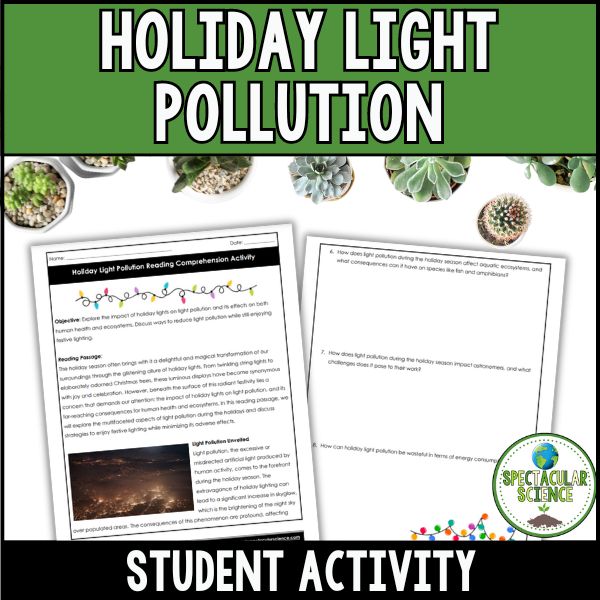
25 hands-on learning opportunities in other Sciences
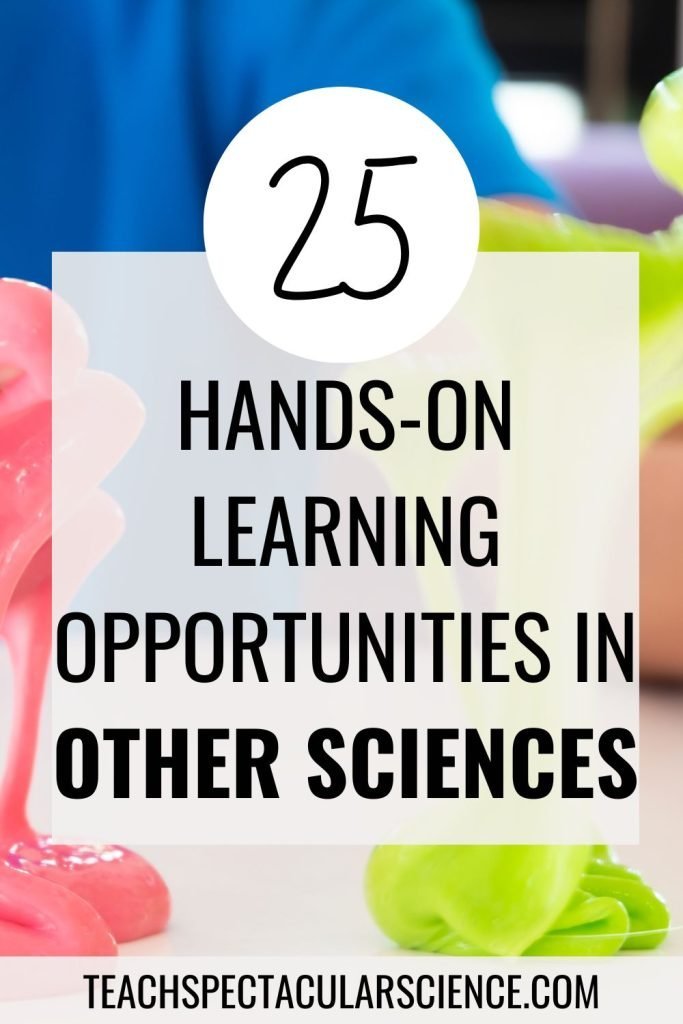
Ignite curiosity across various scientific disciplines with 25 hands-on learning opportunities beyond Earth and environmental science. Uncover the mysteries of physics, chemistry, biology, and more through interactive and educational activities. These experiences create a well-rounded understanding of the scientific world.
- Exploring Density with Layered Liquids: Explore the concept of density by layering liquids of different densities, such as oil, water, and syrup, to observe their stratification.
- Investigating Photosynthesis with Leaf Disc Experiments: Conduct experiments using leaf discs to demonstrate the process of photosynthesis, observing oxygen bubbles released as a result of the reaction.
- Modeling DNA Structure with Candy: Use candy to create a tactile model of DNA, showcasing the double helix structure and the pairing of nucleotide bases.
- Simulating Cell Division with Play-Doh: Represent cell division using Play-Doh to illustrate mitosis and meiosis, making the complex process more tangible and engaging.
- Testing Acids and Bases with Red Cabbage Indicator: Utilize red cabbage as a natural pH indicator to test and classify various substances as acids or bases.
- Constructing 3D Atom Models with Marshmallows: Build 3D models of atoms using marshmallows and toothpicks to visualize the arrangement of protons, neutrons, and electrons.
- Observing Osmosis with Egg Osmometers: Investigate osmosis by placing eggs in different concentrations of solutions, observing changes in size as water moves through the semi-permeable membrane.
- Demonstrating Enzyme Action with Pineapple Juice: Highlight the action of enzymes by using pineapple juice to break down gelatin, simulating the digestive process.
- Analyzing Blood Types with Simulated Blood: Create simulated blood with different antigens to understand blood typing and compatibility.
- Investigating the Effects of Caffeine on Daphnia: Study the impact of caffeine on aquatic organisms like Daphnia to explore ecological and environmental effects.
- Simulating Antibiotic Resistance with Candy Sorting: Use candies to simulate bacterial populations and demonstrate the concept of antibiotic resistance.
- Modeling Natural Selection with Bird Beak Adaptations: Illustrate natural selection by adapting bird beak shapes using tools to collect “food” items, mimicking evolutionary processes.
- Testing Reaction Rates with Alka-Seltzer and Water: Explore chemical reaction rates by varying conditions with Alka-Seltzer and water.
- Exploring Photosynthesis with Floating Spinach Disks: Investigate photosynthesis by observing the floating behavior of spinach disks in different light conditions.
- Investigating Bioluminescence with Glow Sticks: Explore the concept of bioluminescence by activating glow sticks and discussing the chemical reactions involved.
- Constructing Food Chains and Webs with Yarn: Build visual representations of food chains and webs using yarn to depict interconnections between organisms in ecosystems.
- Observing Microbial Growth with Petri Dish Experiments: Study microbial growth by culturing microorganisms in Petri dishes under various conditions.
- Simulating Nervous System Responses with Reflex Arcs: Model reflex arcs using simple setups to demonstrate rapid, involuntary responses in the nervous system.
- Modeling Respiratory System Functions with Balloons: Use balloons to illustrate the mechanics of the respiratory system, emphasizing inhalation and exhalation.
- Investigating Surface Tension with Water Droplets: Explore surface tension by observing the behavior of water droplets on different surfaces.
- Testing Antacid Effectiveness with Vinegar: Assess the effectiveness of antacids by conducting experiments that simulate stomach acidity using vinegar.
- Demonstrating Simple Genetics with Punnett Squares: Use Punnett squares to demonstrate basic principles of genetics, predicting the outcomes of genetic crosses.
- Simulating Natural Selection with Peppered Moths: Use peppered moths to simulate the effects of natural selection based on environmental changes.
- Observing Crystallization with Borax Snowflakes: Witness the process of crystallization by growing borax snowflakes and discussing the formation of crystal structures.
- Analyzing Sound Waves with DIY String Telephones: Explore the properties of sound waves by creating DIY string telephones to demonstrate vibration and transmission of sound.
25 hands-on Interdisciplinary learning Opportunities
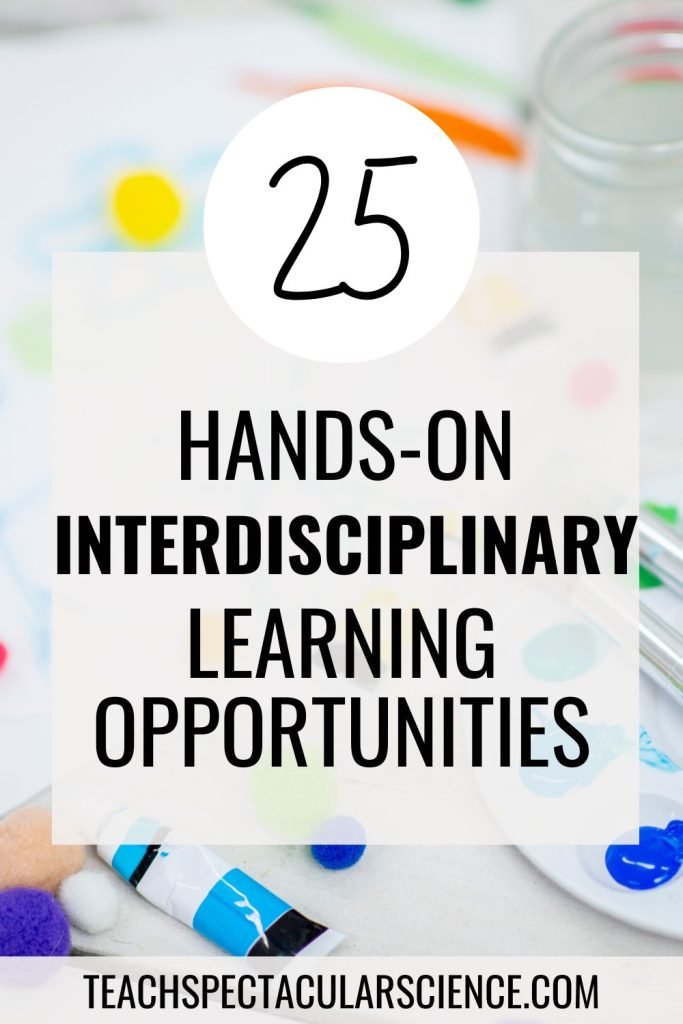
Foster interdisciplinary learning with 25 hands-on activities that seamlessly blend science subjects. These cross-curricular experiences encourage critical thinking and problem-solving skills by integrating elements from Earth science, environmental science, physics, and more. Enhance your students’ education with dynamic, interconnected lessons.
- Recycled Art Sculptures: Fuse environmental science and art by creating sculptures using recycled materials, emphasizing sustainability and creative expression.
- Math in Nature Scavenger Hunt: Combine math and environmental science by sending students on a scavenger hunt to find geometric shapes and patterns in nature.
- Historical Weather Analysis: Merge history and earth science by having students research historical events and analyze corresponding weather patterns to draw connections.
- Physics of Sports: Explore the physics of sports equipment, such as calculating the trajectory of a basketball or understanding the aerodynamics of a soccer ball in motion.
- Chemical Reactions in Cooking: Integrate chemistry and home economics by having students experiment with chemical reactions while cooking, such as leavening agents in baking.
- Geography and Climate Zones: Study the intersection of geography and earth science by examining climate zones worldwide and discussing their impact on ecosystems.
- Literary Element Ecosystems: Connect literature and biology by having students analyze ecosystems within novels, identifying flora and fauna and discussing their roles.
- Music and Sound Waves: Combine physics and music by exploring the science of sound waves, instrument vibrations, and the principles behind musical pitch.
- Historical Geology Timeline: Integrate history and geology by creating a timeline that illustrates the Earth’s geological history alongside major historical events.
- Botanical Illustrations: Merge art and biology by having students create detailed botanical illustrations, focusing on plant structures and adaptations.
- Archaeological Excavation Simulation: Blend history and earth science by organizing a simulated archaeological dig, allowing students to uncover and analyze artifacts.
- Eco-Friendly Urban Planning: Combine environmental science and geography by having students design eco-friendly urban plans that consider sustainability and green spaces.
- Digital Storytelling of Scientific Discoveries: Integrate technology and science by having students create digital stories or presentations showcasing notable scientific discoveries.
- Statistical Analysis of Climate Data: Merge mathematics and environmental science by having students collect and analyze climate data, identifying trends and making predictions.
- Health and Nutrition Lab: Combine biology and health sciences by investigating the nutritional content of various foods, linking cellular processes to overall well-being.
- Astronomy and Mythology Connections: Explore the connections between astronomy and mythology by studying how ancient cultures interpreted celestial events in their myths.
- Weather Forecasting Project: Integrate technology, mathematics, and meteorology by having students create their own weather forecasting models using available data.
- Community Garden Project: Blend environmental science, biology, and community outreach by establishing a community garden, fostering teamwork and sustainable practices.
- Physics of Roller Coasters Design Challenge: Combine physics and engineering by having students design and build miniature roller coasters, applying principles of force and motion.
- Culinary Chemistry Extravaganza: Integrate chemistry and culinary arts by experimenting with molecular gastronomy techniques and understanding the chemical reactions in cooking.
- Literary Ecology Analysis: Connect literature and environmental science by analyzing the ecological impact of settings in literary works, discussing the symbiotic relationship between characters and their environment.
- Historical Scientific Innovations Timeline: Merge history and science by creating a timeline highlighting key scientific innovations throughout different historical periods.
- Mathematical Patterns in Nature: Combine mathematics and biology by identifying and exploring mathematical patterns found in the structures of plants, animals, and natural formations.
- Environmental Ethics Debates: Integrate philosophy and environmental science by engaging students in debates about ethical considerations related to environmental issues.
- Digital Mapping of Natural Disasters: Blend geography, technology, and earth science by having students create digital maps showcasing the occurrence and impact of natural disasters around the world.
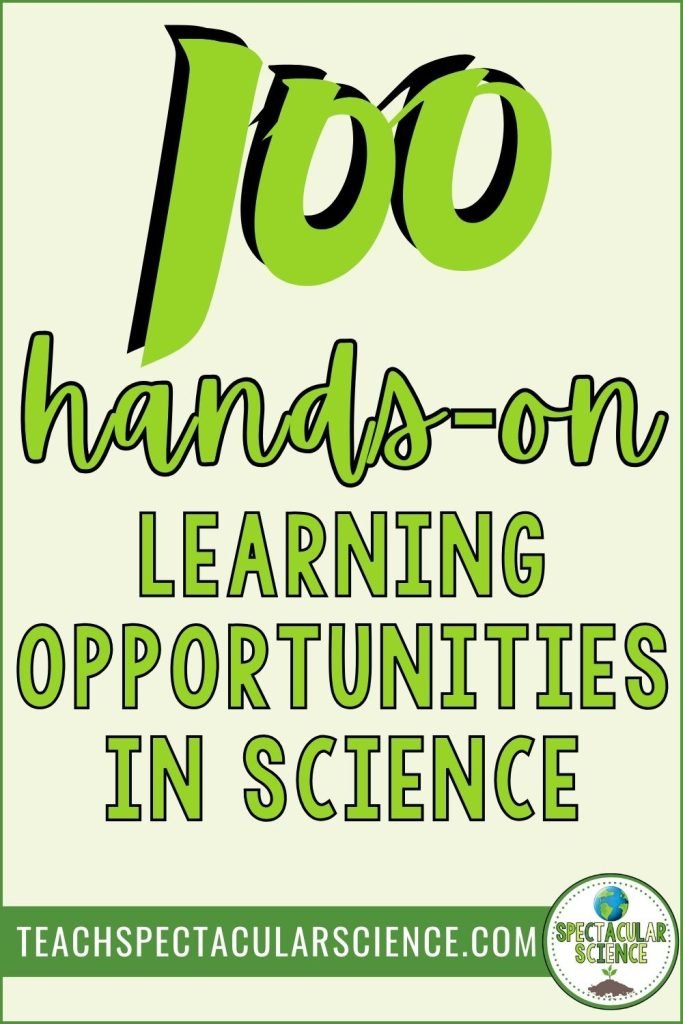
Final Words
The key to fostering curiosity and understanding in our classrooms lies in the diverse array of interactive science activities at our disposal. From captivating experiments to innovative projects, the possibilities are endless. So, here’s your challenge: embrace a little bit more creativity and discovery than you did yesterday.
With each hands-on experience, we not only enrich the minds of our students but also cultivate a lifelong love for science. Here’s to sparking that scientific spark and nurturing the next generation of brilliant minds!
How many of these have you tried with your students? Brag in the comments below. Happy teaching!

